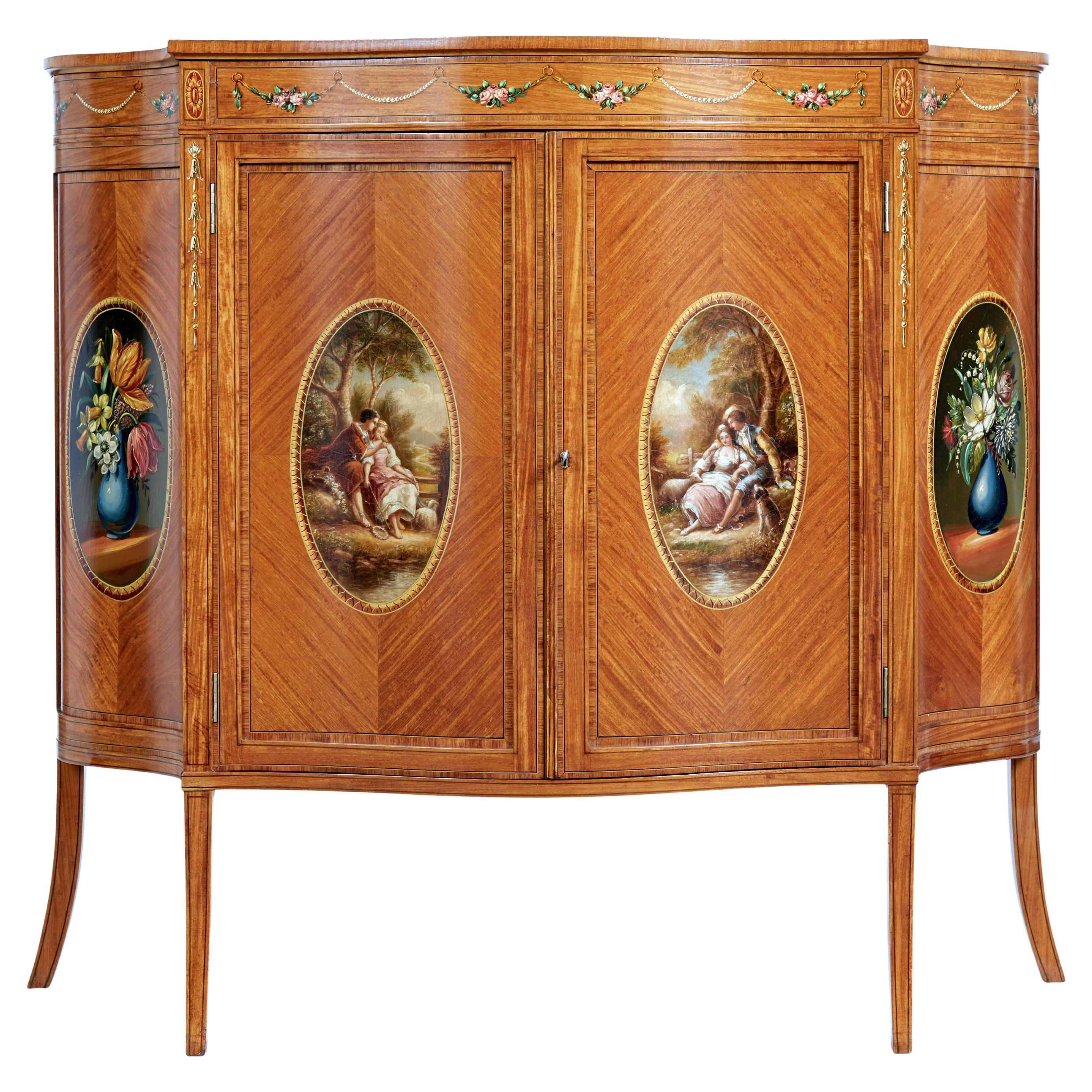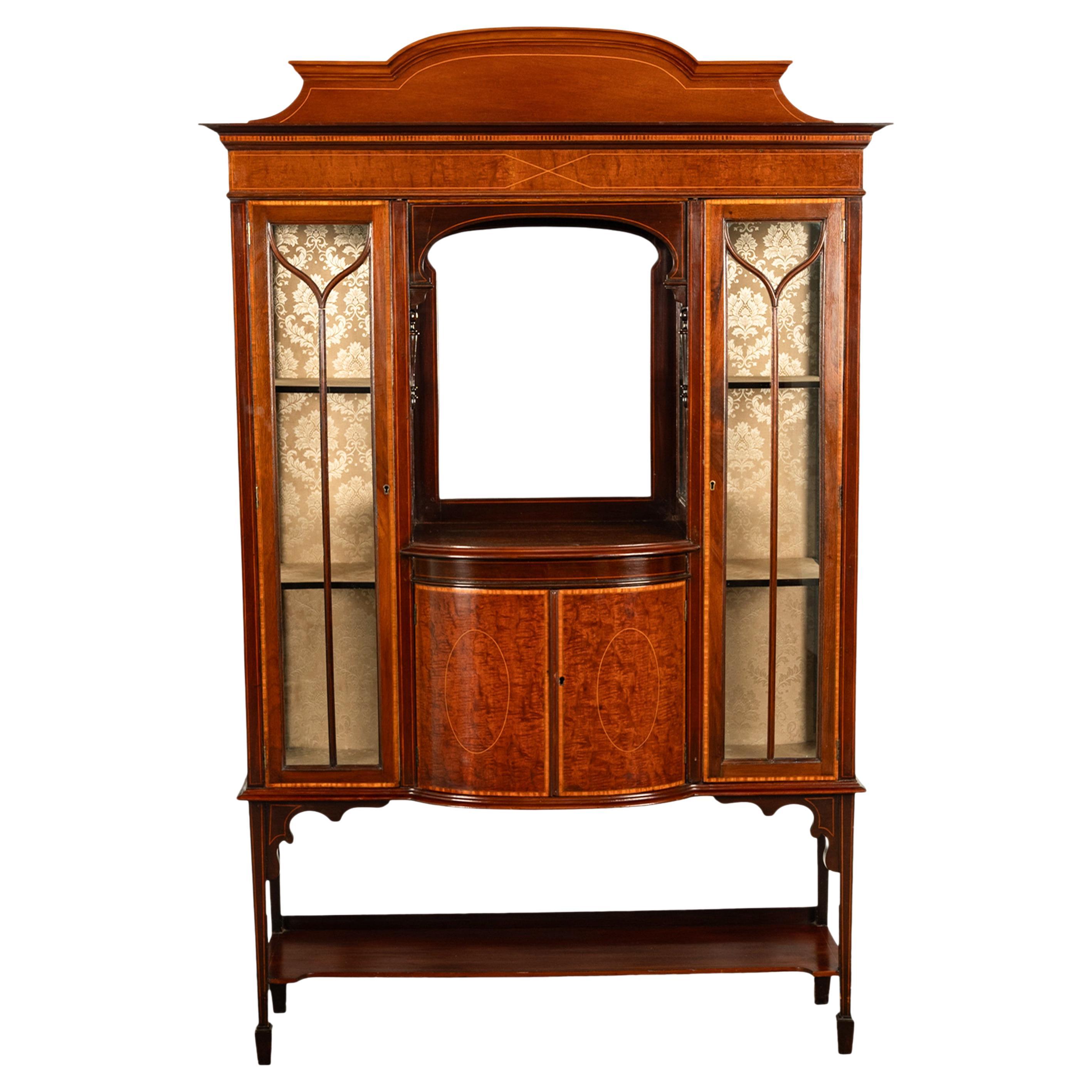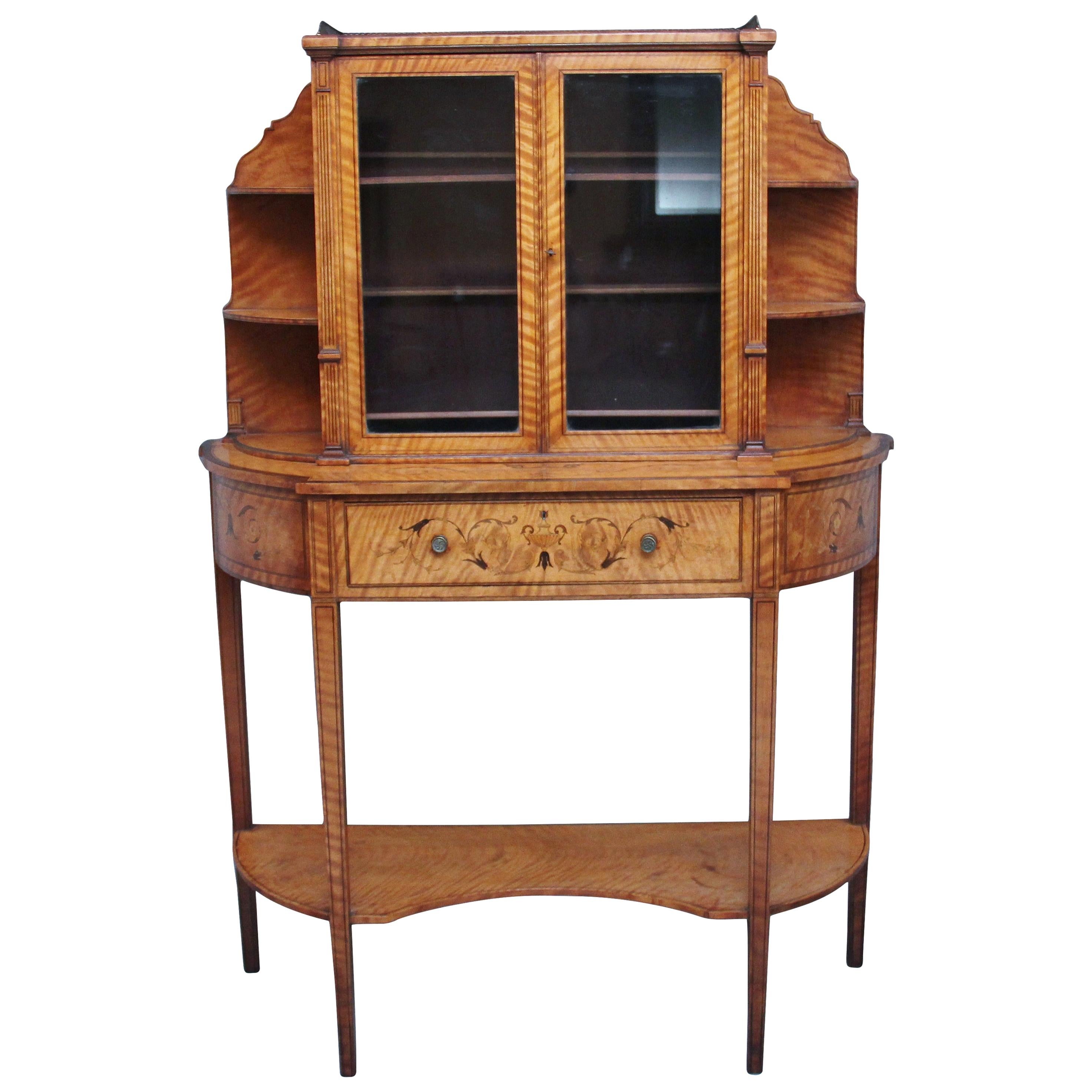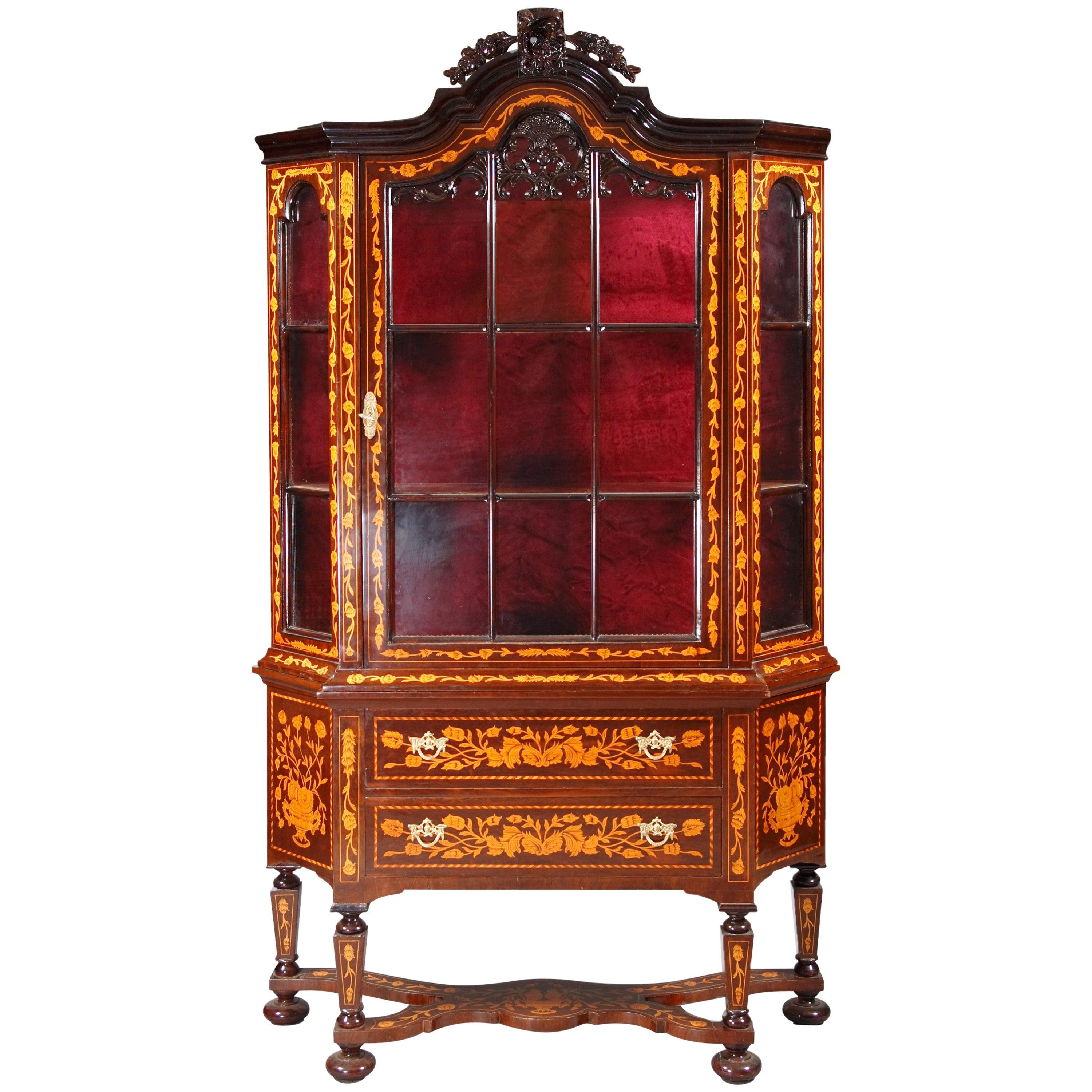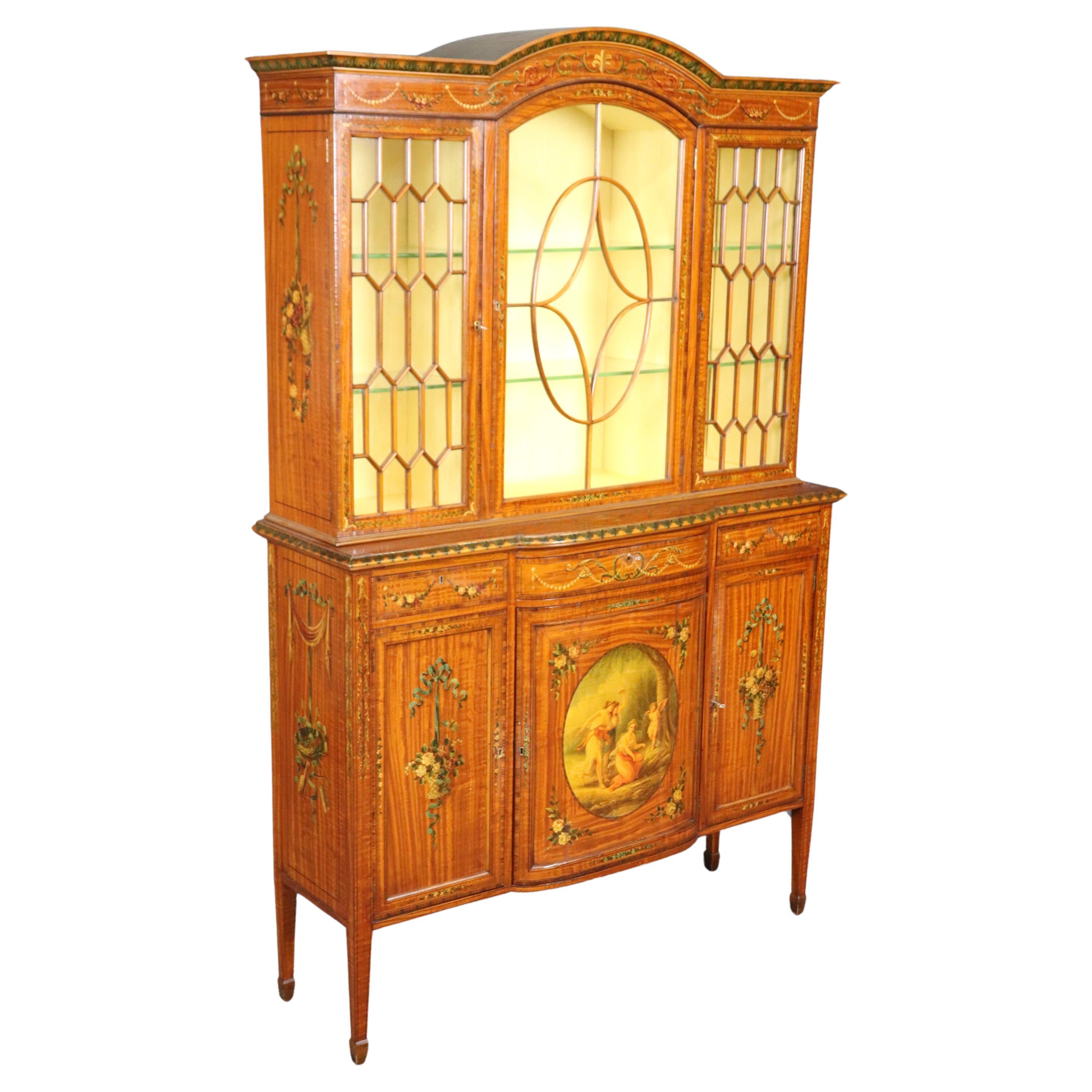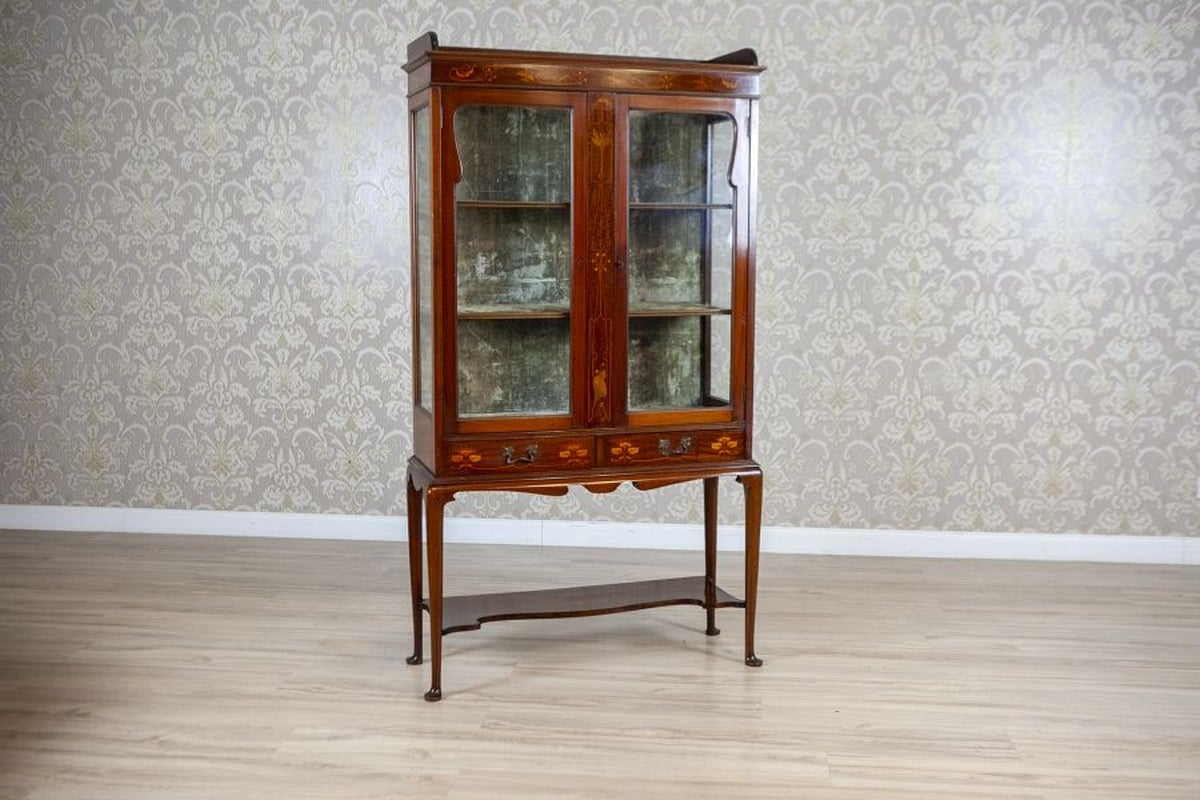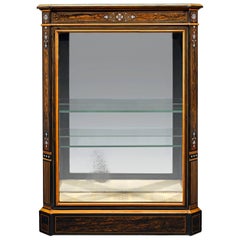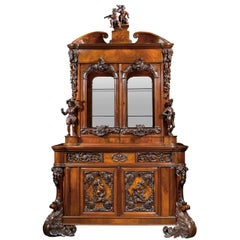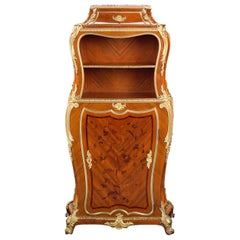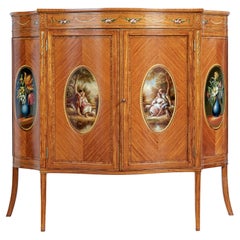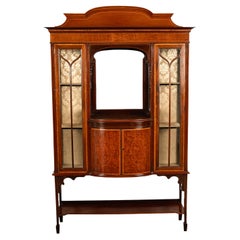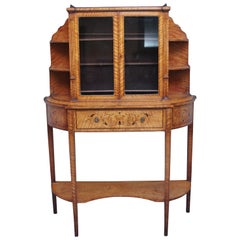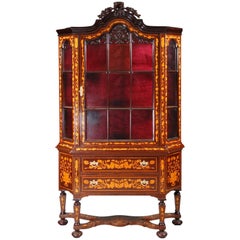Items Similar to Sheraton Revival Hand-Painted Vitrine
Want more images or videos?
Request additional images or videos from the seller
1 of 7
Sheraton Revival Hand-Painted Vitrine
$26,850
£20,435
€23,403.70
CA$38,189.80
A$41,850.57
CHF 21,855.24
MX$502,929.39
NOK 273,228.46
SEK 257,697.98
DKK 174,682.50
About the Item
This exceptional English vitrine features the stylistic elements associated with the famed English furniture designer Thomas Sheraton, considered one of the three most influential English cabinetmakers along with Thomas Chippendale and George Hepplewhite. Crafted of elegant satinwood, the vitrine demonstrates the enduring influence of classical antiquity on English furniture design. Sheraton's book The Cabinet-maker and Upholsterer's Drawing-book left a lasting legacy on English aesthetic tastes.
Sheraton revival style grew in popularity during the Edwardian era. Much like other Edwardian styles, it elevates rectilinear forms, architectural bodies with column-shaped legs, light and elegant frames and a preference for wood inlays and veneers. This vitrine features painted allegorical scenes and is chased with floral and ribbon motifs. Elegant and refined, this vitrine remains a testament to the beauty of a bygone era.
Circa 1870
Measures: 65 1/4" high x 49 1/4" wide x 15" deep.
- Dimensions:Height: 65.25 in (165.74 cm)Width: 49.25 in (125.1 cm)Depth: 15 in (38.1 cm)
- Style:Sheraton (In the Style Of)
- Materials and Techniques:
- Place of Origin:
- Period:
- Date of Manufacture:circa 1870
- Condition:
- Seller Location:New Orleans, LA
- Reference Number:Seller: 31-36421stDibs: LU891130362992
About the Seller
5.0
Recognized Seller
These prestigious sellers are industry leaders and represent the highest echelon for item quality and design.
Established in 1912
1stDibs seller since 2010
112 sales on 1stDibs
Typical response time: 9 hours
- ShippingRetrieving quote...Shipping from: New Orleans, LA
- Return Policy
Authenticity Guarantee
In the unlikely event there’s an issue with an item’s authenticity, contact us within 1 year for a full refund. DetailsMoney-Back Guarantee
If your item is not as described, is damaged in transit, or does not arrive, contact us within 7 days for a full refund. Details24-Hour Cancellation
You have a 24-hour grace period in which to reconsider your purchase, with no questions asked.Vetted Professional Sellers
Our world-class sellers must adhere to strict standards for service and quality, maintaining the integrity of our listings.Price-Match Guarantee
If you find that a seller listed the same item for a lower price elsewhere, we’ll match it.Trusted Global Delivery
Our best-in-class carrier network provides specialized shipping options worldwide, including custom delivery.More From This Seller
View All19th Century French Vitrine by Francois Linke
By François Linke
Located in New Orleans, LA
This rare and stunning vitrine was crafted by the illustrious French ébéniste François Linke. A master of the Louis XVI style, Linke was renowned for his highly original designs that...
Category
Antique 19th Century French Rococo Vitrines
Materials
Bronze
19th Century Coromandel Inlaid Vitrine
Located in New Orleans, LA
Highly-prized coromandel, or East Indian ebony, was used to create this beautiful Victorian vitrine. Featuring delicate inlay in the Victorian/Edwardian style and glass panels framed in the equally luxurious satinwood, this cabinet is constructed to fit flush against a wall with baseboards. Elegant cabinets such as this are perfect for displaying one's treasures, but with original locks, keys, mirrors and fleur-de-lis fabric, this case is a prized possession unto itself,
circa 1890.
Measures: 30" wide x 14 ½" deep x 41 ½" high.
Coromandel ebony is variegated brown and black, often called "streaky," wood. It is considered a highly valuable wood for turnery, fine cabinet...
Category
Antique 19th Century English Victorian Vitrines
Materials
Glass, Mirror, Ebony, Satinwood
19th Century Dutch Bureau Bookcase
Located in New Orleans, LA
This magnificent and important Dutch mahogany bureau bookcase, exuberantly carved and adorned with superb figural carvings, impressive scrolled feet and elaborate applied decoration....
Category
Antique 19th Century Dutch Other Bookcases
Materials
Mahogany
19th Century French Secrétaire by Durand
By Gervais Durand
Located in New Orleans, LA
Superior craftsmanship and intricate marquetry characterize this rare secrétaire by Gervais-Maximilien-Eugène Durand, one of the most popular French ébénistes of the 19th century. Th...
Category
Antique 19th Century French Louis XV Secretaires
Materials
Bronze, Ormolu
Exhibition Satinwood Sideboard By Wright And Mansfield
By Wright and Mansfield
Located in New Orleans, LA
This extraordinary sideboard is attributed to the famed Wright and Mansfield and was only certainly created specifically for the important 19th century international exhibitions. Satinwood, ebony, marble and doré bronze of superior quality, are combined with a classical theme culminating in this neoclassical masterpiece. The 19th century marked an era dominated by significant global exhibitions, prompting artisans from diverse fields to push their creative boundaries in crafting exceptionally beautiful and pioneering works. These masterpieces were showcased before an international audience, frequently graced by nobility and royalty from various corners of the globe. The pinnacle of the firm's craftsmanship and artistry, this exquisite sideboard would certainly have been a showpiece for Wright and Mansfield.
Wright and Mansfield was an important and prominent Victorian firm that produced many of the finest pieces of English furniture ever made. They served as Cabinetmakers to Queen Victoria, and several of their pieces are housed and on display at the Victoria and Albert Museum in London. Widely recognized for their superb craftsmanship and innovative designs, they received acclaim for their works exhibited in the 1862 London International Exhibition, the 1867 Paris Exposition Universelle and the 1876 Philadelphia World...
Category
Antique 19th Century English Neoclassical Sideboards
Materials
Marble, Bronze
King George I Ambassadorial Secrétaire-Cabinet
Located in New Orleans, LA
This highly important secrétaire-cabinet was crafted for and specially ordered by King George I for the British Ambassador to Russia. From its craftsmanship and materials to its exceptional artistry, it is a work of royal and historic significance that exudes power in each and every detail. The broken pediment at its apex features the simplified royal coat of arms bearing the king’s crown, while the interior is adorned by portraits of the British Royal Family. Placed within the ambassador’s St. Petersburg home, this entirely unique piece of furniture would have been a potent reminder of England's grandeur and political importance.
Relations between England and Russia during this period were at an all-time high. Peter the Great had traveled to England in 1698 as part of his widely known “Grand Embassy” tour, wherein he attempted to gain foreign support against the Ottoman Empire. He spent a period of nearly four months there, meeting with King William III and his court on numerous occasions. Noted academic Arthur MacGregor wrote concerning the impact of the trip, “For two decades following Peter's visit, British influence in Russia reached a peak. It manifested itself in social custom, in craft practice and in ships and naval organization... it reached a significant sector of the population before relations cooled once again and the two nations pulled back from this era of unprecedented cordiality.”
First and foremost, however, it is a reminder of British might and influence. By the reign of King George I, England had come into its own as a world power. Unique in its design, this cabinet is a reflection of the country’s might. It is crafted from the highest-quality solid walnut and burr walnut adorned by gilded lock plates and engraved hinges. The presence of ormolu at its apex and lining the doors was a rarity for this period, and its addition makes manifest the importance of the design.
The outer doors open to reveal multiple interiors, including fifteen separate drawers around a central cupboard; the cupboard doors each bear mezzotint portraits of George I and his father, Ernest Augustus, Elector of Hanover. An etching after the portrait of George I dating to circa 1716 is in London’s Royal Academy. A second, inner pair of doors are adorned by mezzotints of the Prince and Princess of Wales (later Queen Caroline and George II), which are both after portraits by Sir Godfrey Kneller dated 1716 in the Royal Collection. A final portrait is revealed on the very interior of the cabinet, where a mezzotint of Frederick, Anne, Amelia and Caroline, children of the Prince of Wales, resides. An etching (circa 1715-1720) after this portrait can be found in the National Portrait Gallery (London).
Apart from its abundance of royal portraiture, the cabinet features stunning painted decoration, including floral designs as well as clouds, birds and trees in a bucolic motif reminiscent of Eden. Its lower portion is a study in both form and function, featuring a fitted secrétaire-drawer above three additional drawers for storage. The cabinet appears in The Shorter Dictionary of English Furniture by R. Edwards from 1964, a text that is regarded as the bible of British furniture design. Edwards describes it as a “writing cabinet...given by George I to the British Ambassador at the Russian court.”
The cabinet was likely made for the 18th-century German diplomat and writer Friedrich Christian Weber, who represented English interests at the Russian court from 1714 until 1719. Although Weber’s tenure as ambassador was relatively short, while in St. Petersburg, he authored his account entitled Das veraenderte Russland (The Present State of Russia), which was published in three volumes in 1721, 1739 and 1740. It may, however, also have been made for George Douglas, 2nd Earl of Dumbarton, who served as ambassador alongside Weber in 1716. Diplomatic relations ceased between the two countries in 1721.
In 1928, the cabinet appeared for sale at the International Exhibition of Antiques & Works of Art in Olympia. It had previously been in the collection of the Woltner family of Bordeaux, the celebrated vintners who owned the estate Château Laville Haut-Brion and produced wine of the same name. According to the family, Monsieur Woltner was given the cabinet as a gift from an aunt who lived in Russia for many years. After leaving the Woltner collection, the cabinet was acquired by William Berry...
Category
Antique 18th Century English Georgian Secretaires
Materials
Brass
You May Also Like
19th century Sheraton revival satinwood inlaid and painted cabinet
Located in Debenham, Suffolk
Late 19th century Sheraton revival satinwood inlaid and painted cabinet circa 1895.
Stunning 2 door serpentine fronted cabinet standing on 4 tapered legs. Hand painted 4 plaques to ...
Category
Antique Late 19th Century English Sheraton Sideboards
Materials
Satinwood, Paint
Antique Sheraton Regency Revival Inlaid Display Case China Cabinet Hutch 1900
Located in Portland, OR
A very fine & elegant antique inlaid mahogany Edwardian Sheraton, Regency Revival china cabinet, hutch, circa 1900.
The cabinet having an inlaid arched gallery to the top, the cabine...
Category
Antique Early 1900s English Regency Revival Cabinets
Materials
Mirror, Mahogany, Satinwood
19th Century Satinwood Display Cabinet
Located in Martlesham, GB
19th century satinwood display cabinet in the Sheraton style, having a pierced brass gallery above two glazed doors, opening to reveal two sh...
Category
Antique 1890s British Sheraton Cabinets
Materials
Satinwood
$2,679 Sale Price
26% Off
20th Century, Vitrine with Fine Inlay in the Dutch Baroque Style Mahogany Veneer
Located in Berlin, DE
Light mahogany and maple on solid wood. Very rich, Baroque inlaid work. High-corpuscular body. On balustrade-shaped legs connected with an X-shaped ridge. Above two-wise frame base with profiled cover plate. Three-sided sprout-glazed, single-door display case. Interior shelves, wall covered...
Category
20th Century Dutch Baroque Vitrines
Materials
Mahogany
Rare Satinwood Vernis Martin Paint Decorated Adams Style Vitrine China Cabinet
Located in Swedesboro, NJ
This rare Satinwood Vernis Martin paint-decorated Adams Style Vitrine China Cabinet is a museum-quality piece that exudes refinement and artistry. Crafted in the Adams style, this ex...
Category
Antique Early 1900s English Adam Style Vitrines
Materials
Glass, Satinwood
$5,996 Sale Price
20% Off
English Inlaid Mahogany Display Cabinet From the 19th Century
Located in Opole, PL
English Inlaid Mahogany Display Cabinet From the 19th Century
Step into timeless elegance with this exquisite antique display cabinet, a captivating ...
Category
Antique Early 19th Century English Art Nouveau Vitrines
Materials
Mahogany, Glass, Wood
$2,759 Sale Price
20% Off
More Ways To Browse
English Antique Furniture
Sheraton Antique Furniture
Thomas Sheraton
Antique Drawing Book
Corner Cabinet Dining Room
Bombe Vitrine
Glass Case Display Table
Iron Medical Cabinet
Antique Glass Display Table
German Display Cabinet
Small Vitrine
Mahogany Vitrine English
Medical Vitrine
Vitrine With Mirror
Giltwood Display Cabinet
Louis Curio
Baroque Display Cabinet
Mastercraft Brass Vitrine
